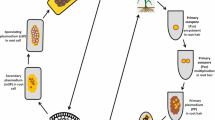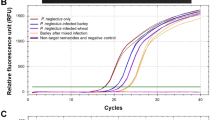Abstract
Fusarium foetens is a recently described aggressive vascular pathogen of Begonia x hiemalis. Since 2004, it has caused severe losses for Begonia growers in Northern Europe and North America. F. foetens is likely to be of exotic origin. Little is known about the accumulation of the fungus in Begonia plants before and during symptom expression and about its host range. We have optimised a molecular detection method for F. foetens by only using the plant part containing the largest amount of the pathogen and by optimising the tissue maceration and DNA extraction techniques. This allowed a reliable detection limit of 2310 spore equivalents per plant and a theoretical detection limit of as low as 84 to 167 spore equivalents per plant. Using this method, we demonstrated exponential accumulation of F. foetens DNA in Begonia roots, resulting in symptoms at a threshold of approximately 107 spore equivalents and levelling off at 109 spore equivalents per plant. The observed rate of accumulation and the amount of pathogen DNA in non-symptomatic plants can be combined to determine whether the cuttings were infected after delivery at the Begonia nursery and to calculate the estimated timing of symptom development. To test the host range, we applied the optimised molecular detection technique. During these tests, only Begonia x hiemalis plants became symptomatic, but many other plant species supported growth of the pathogen. This information can be used to aid pathogen control and has implications for pest risk assessment.



Similar content being viewed by others
Abbreviations
- dpi:
-
Days post inoculation
- FSM:
-
Fusarium selective medium
- GE Kit:
-
GenElute plant genomic DNA kit
- ISP Kit:
-
Invisorb spin plant mini kit
- PDA/B:
-
Potato dextrose agar/broth
- QP (+ MC) Kit:
-
Quick pick SML pant DNA kit (+ MagaCharc beads)
- wpi:
-
Weeks post inoculation
References
Alaei, H., Baeyen, S., Maes, M., Höfte, M., & Heungens, K. (2009). Molecular detection of Puccinia horiana in Chrysanthemum x morifolium through conventional and real-time PCR. Journal of Microbiological Methods, 76, 136–145.
Anonymous. (2007). Report of a pest risk analysis: Fusarium foetens. EPPO Document nr 07–13609. Retrieved January 2011, from http://www.eppo.org/QUARANTINE/Pest_Risk_Analysis/PRA_documents.htm
Atallah, Z. K., Bae, J., Jansky, S. H., Rouse, D. I., & Stevenson, W. R. (2007). Multiplex real-time quantitative PCR to detect and quantify Verticillium dahliae colonization in potato lines that differ in response to Verticillium wilt. Phytopathology, 97, 865–872.
Baayen, R. P., Cevat, H. N., de Hoop, B. (2002). PRA Fusarium species on Begonia. EPPO Document Nr 07–13296. Retrieved January 25th, 2011, from http://www.eppo.org/QUARANTINE/Pest_Risk_Analysis/PRA_documents.htm
de Weerdt, M., Zijlstra, C., van Brouwershaven, I. R., van Leeuwen, G. C. M., de Gruyter, J., & Kox, L. F. F. (2006). Molecular detection of Fusarium foetens in Begonia. Journal of Phytopathology, 154, 694–700.
Debode, J., Van Hemelrijck, W., Baeyen, S., Creemers, P., Heungens, K., & Maes, M. (2009). Quantitative detection and monitoring of Colletotrichum acutatum in strawberry leaves using real-time PCR. Plant Pathology, 58, 504–514.
Demontis, M. A., Cacciola, S. O., Orrù, M., Balmas, V., Chessa, V., Maserti, B. E., et al. (2008). Development of real-time PCR systems based on SYBR® Green I and TaqMan® technologies for specific quantitative detection of Phoma tracheiphila in infected Citrus. European Journal of Plant Pathology, 120, 339–351.
Elmer, W. H. (2008). Preventing spread of Fusarium wilt of Hiemalis begonias in the greenhouse. Crop Protection, 27, 1078–1083.
Elmer, W. H., & Vossbrinck, C. (2004). First report of a wilt disease of Hiemalis begonias caused by Fusarium foetens in the United States. Plant Disease, 88, 1287–1287.
Gardes, M., & Bruns, T. D. (1993). ITS primers with enhanced specificity for Basidiomycetes–application to the identification of Mycorrhizae and rusts. Molecular Ecology, 2, 113–118.
Jones, D. (2002). PRA for interception: Fusarium foetens. CSL UK PPP10122
Klimyuk, V. I., Carroll, B. J., Thomas, C. M., & Jones, J. D. G. (1993). Alkali treatment for rapid preparation of plant material for reliable PCR analysis. The Plant Journal, 3, 493–494.
Komada, H. (1975). Development of a selective medium for quantitative isolation of Fusarium oxysporum from natural soils. Review of Plant Protection Research, 8, 114–125.
Kroes, R., Müller, D., Lambe, J., Löwik, M. R. H., van Klaveren, J., Kleiner, J., et al. (2002). Assessment of intake from the diet. Food and Chemical Toxicology, 40, 327–385.
Malvick, D. K., & Impullitti, A. E. (2007). Detection and quantification of Phialophora gregata in soybean and soil samples with a quantitative, real-time PCR assay. Plant Disease, 91, 735–742.
Markakis, E. A., Tjamos, S. E., Antoniou, P. P., Paplomatas, E. J., & Tjamos, E. C. (2009). Symptom development, pathogen isolation and real-time qPCR quantification as factors for evaluating the resistance of olive cultivars to Verticillium pathotypes. European Journal of Plant Pathology, 124, 603–611.
Moradi, M., Oerke, E. C., Steiner, U., Schellander, K., & Dehne, H. W. (2010). Microbiological and SYBR green real-time PCR detection of the major Fusarium head blight pathogens on wheat ears. African Journal of Microbiology Research, 4, 1363–1372.
Rossi, V., Terzi, V., Moggi, F., Morcia, C., Faccioli, P., Haidukowski, M., et al. (2007). Assessment of Fusarium infection in wheat heads using a quantitative polymerase chain reaction (qPCR) assay. Food Additives and Contaminants, 24, 1121–1130.
Schroers, H. J., Baayen, R. P., Meffert, J. P., de Gruyter, J., Hooftman, M., & O'Donnell, K. (2004). Fusarium foetens, a new species pathogenic to Begonia elatior hybrids (Begonia x hiemalis) and the sister taxon of the Fusarium oxysporum species complex. Mycologia, 96, 393–406.
Tian, X. L., Dixon, M., & Zheng, Y. (2010). First report of Hiemalis begonias wilt disease caused by Fusarium foetens in Canada. Plant Disease, 94, 1261.
Tschöpe, B., Hey, M., Wohanka, W., & Hennig, F. (2007). Characterisation and identification of Fusarium foetens, causative agent of wilting and stem rot of Begonia Elatior Hybrids (Begonia x hiemalis) by its volatile compounds. European Journal of Horticultural Science, 72, 152–157.
Vandroemme, J., Baeyen, S., Van Vaerenbergh, J., De Vos, P., & Maes, M. (2008). Sensitive real-time PCR detection of Xanthomonas fragariae in strawberry plants. Plant Pathology, 57, 438–444.
Van Hemelrijck, W., Debode, J., Heungens, K., Maes, M., & Creemers, P. (2010). Phenotypic and genetic characterization of Colletotrichum isolates from Belgian strawberry fields. Plant Pathology, 59, 853–861.
Zellerhoff, N., Jarosch, B., Groenewald, J. Z., Crous, P. W., & Schaffrath, U. (2006). Nonhost resistance of barley is successfully manifested against Magnaporthe grisea and a closely related Pennisetum-infecting lineage but is overcome by Magnaporthe oryzae. Molecular Plant-Microbe Interactions, 19, 1014–1022.
Acknowledgements
This research was funded by the Belgian Federal Public Service “Health, Food Chain Safety and Environment”, project RT-06/2–PRAVEG. We would like to thank the Flemish Begonia growing companies for their cooperation, useful information and plant samples. We thank the Belgian Federal Agency for the Safety of the Food Chain (FAVV) (NRL agreement10-ILVOCRA-PLANTEN) for partial financial support of this project. We thank Miriam Levenson for English language editing.
Author information
Authors and Affiliations
Corresponding author
Rights and permissions
About this article
Cite this article
Huvenne, H., Debode, J., Maes, M. et al. Real-time PCR mediated monitoring of Fusarium foetens in symptomatic and non-symptomatic hosts. Eur J Plant Pathol 131, 705–717 (2011). https://doi.org/10.1007/s10658-011-9844-9
Accepted:
Published:
Issue Date:
DOI: https://doi.org/10.1007/s10658-011-9844-9




